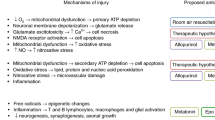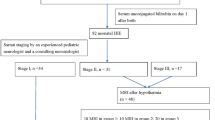Abstract
Antioxidant properties of bilirubin have been reported in many studies. We hypothesized that bilirubin might be involved in neuroprotection mechanisms against oxidative stress in infants with hypoxic–ischemic encephalopathy (HIE) and that total serum bilirubin (TSB) might increase in these patients. We retrospectively studied infants with gestational age ≥ 35 weeks and birth weight ≥ 1800 g who were admitted to the neonatal intensive care unit (NICU) with a diagnosis of moderate-to-severe HIE and received or did not receive therapeutic hypothermia. We evaluated peak TSB and changes of mean TSB in these patients in comparison with a control group of infants admitted to the NICU with diagnoses other than HIE. Peak and mean TSB values were lower in the no hypothermia and hypothermia groups in comparison with the control group, while differences were not noted between infants who received hypothermia or did not. Regression analysis showed that HIE and hypothermia significantly reduced the risk of developing TSB values higher than median value (> 8.4 mg/dL) in our population.
Conclusion: Peak and mean TSB values were lower in infants with moderate-to-severe HIE than in control infants. HIE and hypothermia independently decreased TSB. These results exclude a TSB increase as a neuroprotective mechanism in infants with HIE. We speculated that low TSB values in infants with HIE could be due to hypoxic repression of HO expression and represent a defensive strategy for limiting brain injuries in these patients.
What is Known: • The role of oxidative stress in the pathophysiology of hypoxic–ischemic encephalopathy (HIE) has been elucidated in many studies, and other studies have demonstrated the antioxidant properties of bilirubin. • The potential neuroprotective role of bilirubin as antioxidant agent has never been evaluated in infants with HIE. | |
What is New: • Mean total serum bilirubin (TSB) values are lower in infants with moderate-to-severe HIE than in control infants, since HIE and hypothermia independently decreased TSB. • An increase in bilirubin was not a neuroprotective mechanism in infants with HIE possibly because of hypoxic repression of HO expression as defensive strategy for limiting brain injuries. |

Similar content being viewed by others
Abbreviations
- HO:
-
Heme-oxygenase
- HIE:
-
Hypoxic–ischemic encephalopathy (HIE)
- TSB:
-
Total serum bilirubin
- NICU:
-
Neonatal intensive care unit
References
American Academy of Pediatrics Subcommittee on Hyperbilirubinemia (2004) Management of hyperbilirubinemia in the newborn infant 35 or more weeks of gestation. Pediatrics 114:297–316
Ancora G, Pomero G, Ferrari F (2012) Raccomandazioni per l’assistenza al neonato con encefalopatia ipossico-ischemica candidato al trattamento ipotermico, 2nd edn. Biomedia Ed, Milan, pp 1–47
Badawi N, Felix JF, Kurinczuk JJ, Dixon G, Watson L, Keogh JM, Valentine J, Stanley FJ (2005) Cerebral palsy following term newborn encephalopathy: a population-based study. Dev Med Child Neurol 47:293–298
Basu S, De D, Khanna HD, Kumar A (2017) Lipid peroxidation, DNA damage and total antioxidant status in neonatal hyperbilirubinemia. J Perinatol 34:519–523
Belanger S, Lavole JC, Chessex P (1994) Influence of bilirubin on the antioxidant capacity of plasma in newborn infants. Biol Neonate 71:233–238
Choudhary M, Sharma D, Dabi D, Lamba M, Pandita A, Shastri S (2015) Hepatic dysfunction in asphyxiated neonates: prospective case-controlled study. Clin Med Insights Pediatr 12:1–6
Cowan F, Rutherford M, Groenendaal F, Eken P, Mercuri E, Bydder GM Meiners LC, Dubowitz LM, de Vries LS (2003) Origin and timing of brain lesions in term infants with neonatal encephalopathy. Lancet 361:736–742
Dennery PA, McDonagh AF, Spitz DR, Rodgers PA, Stevenson DK (1995) Hyperbilirubinemia results in reduced oxidative injury in neonatal Gunn rat exposed in hyperoxia. Free Radic Biol Med 19:395–404
Doğan M, Peker E, Kirimi E, Sal E, Akbayram S, Erel O, Ocak AR, Tuncer O (2011) Evaluation of oxidant and antioxidant status in infants with hyperbilirubinemia and kernicterus. Hum Exp Toxicol 30:1751–1760
Douglas-Escobar M, Weiss MD (2015) Hypoxic-ischemic encephalopathy: a review for the clinician. JAMA Pediatr 169:397–403
Edwards AD, Brocklehurst P, Gunn AJ, Halliday H, Juszczak E, Levene M, Strohm B, Thoresen M, Whitelaw A, Azzopardi D (2010) Neurological outcomes at 18 months of age after moderate hypothermia for perinatal hypoxic ischaemic encephalopathy: synthesis and meta-analysis of trial data. BMJ 340:c363
Falcão AS, Silva RF, Fernandes A, Brito MA, Brites D (2007) Influence of hypoxia and ischemia preconditioning on bilirubin damage to astrocytes. Brain Res 1149:191–199
Gopinathan V, Miller NJ, Milner AD, Rice-Evans CA (1994) Bilirubin and ascorbate antioxidant activity in neonatal plasma. FEBS Lett 349:197–200
Grojean S, Lievre V, Koziel V, Vert P, Daval JL (2001) Bilirubin exerts additional toxic effects in hypoxic cultured neurons from the developing rat brain by the recruitment of glutamate neurotoxicity. Pediatr Res 49:507–513
Grojean S, Vert P, Daval JL (2002) Combined effects of bilirubin and hypoxia on cultured neurons from the developing rat forebrain. Semin Perinatol 26:416–424
Jacobs SE, Berg M, Hunt R, Tarnow-Mordi WO, Inder TE, Davis PG (2013) Cooling for newborns with hypoxic ischaemic encephalopathy. Cochrane Database Syst Rev 31:CD003311
Jiang W, Desjardins P, Butterworth RF (2009) Hypothermia attenuates oxidative/nitrosative stress, encephalopathy and brain edema in acute (ischemic) liver failure. Neurochem Int 55:124–128
Kitamuro T, Takahashi K, Ogawa K, Udono-Fujimori R, Takeda K, Furuyama K, Nakayama M, Sun J, Fujita H, Hida W, Hattori T, Shirato K, Igarashi K, Shibahara S (2003) Bach1 functions as a hypoxia-inducible repressor for the heme oxygenase-1 gene in human cells. J Biol Chem 278:9125–9133
Karlsson M, Blennow M, Nemeth A, Winbladh B (2006) Dynamics of hepatic enzyme activity following birth asphyxia. Acta Paediatr 95:1405–1411
Kumar A, Pant P, Basu S, Rao GR, Khanna HD (2007) Oxidative stress in neonatal hyperbilirubinemia. J Trop Pediatr 53:69–717
Kurinczuk JJ, White-Koning M, Badawi N (2010) Epidemiology of neonatal encephalopathy and hypoxic-ischaemic encephalopathy. Early Hum Dev 86:329–338
Miller NJ, Rice-Evans C, Davies MJ, Gopinathan V, Milner A (1993) A novel method for measuring antioxidant capacity and its application to monitoring the antioxidant status in premature neonates. Clin Sci 84:407–412
Mireles LC, Lum MA, Dennery PA (1999) Antioxidant and cytotoxic effects of bilirubin on neonatal erythrocytes. Pediatr Res 45:355–362
Muniraman H, Gardner D, Skinner J, Paweletz A, Vayalakkad A, Chee YH, Clifford C, Sanka S, Venkatesh V, Curley A, Victor S, Turner MA, Clarke P (2017) Biomarkers of hepatic injury and function in neonatal hypoxic ischemic encephalopathy and with therapeutic hypothermia. Eur J Pediatr 176:1295–1303
Nakayama M, Takahashi K, Kitamuro T, Yasumoto K, Katayose D, Shirato K, Fujii-Kuriyama Y, Shibahara S (2000) Repression of heme oxygenase-1 by hypoxia in vascular endothelial cells. Biochem Biophys Res Commun 271:665–671
Riljak V, Kraf J, Daryanani A, Jiruška P, Otáhal J (2016) Pathophysiology of perinatal hypoxic-ischemic encephalopathy—biomarkers, animal models and treatment perspectives. Physiol Res 65:S533–S545
Romagnoli C, Barone G, Pratesi S, Raimondi F, Capasso L, Zecca E, Dani C (2014) Task force for Italian guidelines for management and treatment of hyperbilirubinaemia of newborn infants ≥ 35 weeks’ gestational age. Hyperbilirubinaemia of the Italian Society of Neonatology Ital J Pediatr 40:11
Sarnat HB, Sarnat MS (1976) Neonatal encephalopathy following fetal distress: a clinical and electroencephalographic study. Arch Neurol 33:696–705
Stocker S, Yamamoto Y, McDonagh AF, Glazer AN, Ames BN (1987) Bilirubin is an antioxidant of possible physiological importance. Science 235:1043–1046
Stocker R, Ames BN (1987) Potential role of conjugated bilirubin and copper in the metabolism of lipid peroxides. PNAS 84:8130–8134
Stocker R, Glazer AN, Ames BN (1987) Antioxidant activity of albumin-bound bilirubin. PNAS 84(16):5918–5922
Thornton C, Leaw B, Mallard C, Nair S, Jinnai M, Hagberg H (2017) Cell death in the developing brain after hypoxia-ischemia. Front Cell Neurosci 11:248
Thornton C, Baburamani AA, Kichev A, Hagberg H (2017) Oxidative stress and endoplasmic reticulum (ER) stress in the development of neonatal hypoxic-ischaemic brain injury. Biochem Soc Trans 45:1067–1076
Wu TW, Wu J, Li RK, Mickle D, Carey D (1991) Albumin-bound bilirubin protects human ventricular myocytes against oxyradical damage. Biochem Cell Biol 169:683–688
Xia D, Zhang H (2017) Effects of mild hypothermia on expression of NF-E2-related factor 2 and heme-oxygenase-1 in cerebral cortex and hippocampus after cardiopulmonary resuscitation in rats. Iran J Basic Med Sci 20:1002–1008
Yigit S, Yurdakok M, Kilinc K, Oran O, Erdem G, Tekinalp G (1999) Serum malondialdehyde concentrations in babies with hyperbilirubinemia. Arch Dis Child Fetal Neonat Ed 80:F235–F237
Yu T, Kui LQ, Ming QZ (2003) Effect of asphyxia on non-protein-bound iron and lipid peroxidation in newborn infants. Dev Med Child Neurol 45:24–27
Zhang Y, Furuyama K, Kaneko K, Ding Y, Ogawa K, Yoshizawa M, Kawamura M, Takeda K, Yoshida T, Shibahara S (2006) Hypoxia reduces the expression of heme oxygenase-2 in various types of human cell lines. A possible strategy for the maintenance of intracellular heme level. FEBS J 273:3136–3147
Funding
This study was carried out without specific funding.
Author information
Authors and Affiliations
Contributions
CD designed the study, supervised data collection, carried out the analyses, drafted the manuscript, and approved the final manuscript as submitted. CP, CD, and SP performed the data collection, participated in data analysis, reviewed and revised the manuscript, and approved the final manuscript as submitted.
Corresponding author
Ethics declarations
Conflict of interest
Authors declare that they have no conflicts of interest.
Ethical approval
All procedures performed in studies involving human participants were in accordance with the ethical standards of the institutional and/or national research committee and with the 1964 Helsinki declaration and its later amendments or comparable ethical standards. Informed consent was obtained from all individual participants included in the study.
Additional information
Communicated by Patrick Van Reempts
Rights and permissions
About this article
Cite this article
Dani, C., Poggi, C., Fancelli, C. et al. Changes in bilirubin in infants with hypoxic–ischemic encephalopathy. Eur J Pediatr 177, 1795–1801 (2018). https://doi.org/10.1007/s00431-018-3245-4
Received:
Revised:
Accepted:
Published:
Issue Date:
DOI: https://doi.org/10.1007/s00431-018-3245-4




